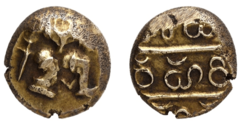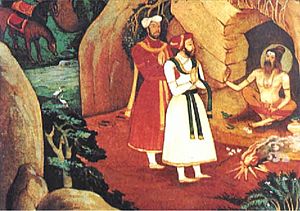Harihara I facts for kids
Quick facts for kids Harihara I |
|
|---|---|

Pagoda of Harihara I
|
|
| Vijayanagara Emperor | |
| Reign | 1336 – 1356 (unofficial) |
| Predecessor | Position established (Veera Ballala III as Hoysala Emperor) |
| Successor | Bukka Raya I |
| Born | 1306 CE |
| Died | 1356 CE (aged 50) Vijayanagar, Vijayanagara Empire (modern day Hampi, Karnataka, India) |
| House | Sangama |
| Father | Bhavana Sangama |
| Mother | Maravve Nayakiti |
| Religion | Hinduism (1306 - 1323; 1334 - 1356) Sunni Islam (1323 - 1334) |
Harihara I, also known as Hakka or Vira Harihara I, was a very important ruler in Indian history. He founded the powerful Vijayanagara Empire and ruled it from 1336 to 1356 CE. He and the kings who came after him were part of the Sangama dynasty. This was the first of four royal families to rule the empire. Harihara was the oldest son of Bhavana Sangama, who was a leader of a community that raised cows.
Harihara's early life, and that of his brother Bukka, is not fully known. Most of what we know comes from different ideas and theories. We do know that Harihara had a connection to the Hoysala royal family. Ballappa Dandanayaka, who was a nephew of the Hoysala ruler Veera Ballala III, married Harihara's daughter.
After Harihara became a ruler, he quickly built a fort at Barkuru. This fort was on the west coast of what is now Karnataka. Records from 1339 show that he was managing the northern parts of present-day Karnataka. He ruled from his base at Gooty in the Ananthpur district.
Harihara first controlled the northern areas of the Hoysala Empire. After the Hoysala ruler Veera Ballala III died in 1343, Harihara took full control of all Hoysala lands. Inscriptions from his time, written in Kannada, describe him with impressive titles. These include Karnataka Vidya Vilas, meaning "master of great knowledge and skills." He was also called Bhashege tappuva rayara ganda, which means "punisher of kings who break their promises." Another title was Arirayavibhada, meaning "fire to enemy kings."
When the King of Warangal was defeated by Muhammad bin Tughluq, Harihara and his brother Bukka were taken prisoner. They were sent to Delhi, where they became Muslim. Later, they returned to Hinduism. Harihara had several brothers who helped him rule. Kampana managed the Nellur region, Muddppa looked after the Mulabagalu region, and Marappa oversaw Chandragutti. Bukka Raya was his second-in-command.
Harihara's first military actions helped him gain control over the Tungabhadra River valley. Slowly, he expanded his control to parts of Konkan and the Malabar Coast. Around this time, the Hoysala ruler Veera Ballala III died fighting the Sultan of Madurai. This created an empty space of power, allowing Harihara to become a powerful and independent ruler. All the Hoysala territories then came under his control.
An inscription from 1346 talks about a gift to the Sringeri matha (a religious center). It describes Harihara I as the ruler of "the whole country between the eastern and the western seas." It also calls Vidya Nagara (the city of learning) his capital.
Harihara I was followed by his brother Bukka I. Bukka became the most famous of the five rulers from the Sangama dynasty.
How Harihara I Ruled the Empire
Harihara was a very skilled leader. The Vijayanagar Empire was the first kingdom in southern India to control three major language and cultural areas. It brought some political unity to these different regions. The kingdom's government sometimes had strong central control. However, local leaders often tried to gain more power for themselves.
The Sangama brothers originally ruled five provinces (called rajyas). As they conquered more lands, new provinces were added. Within these regions, many different local leaders held power. The main government had departments for collecting taxes and for the military. But, the provincial governors and their helpers were mostly responsible for raising taxes and troops. The central government kept a small army. It also decided how many troops each province had to provide based on its income.
Harihara knew that his new kingdom faced dangers. These threats came from both rival Hindu kings and the Delhi sultans. He made the old fort of Badami stronger to protect against attacks from Delhi. He also fortified Gooty in Anantpur District to guard against the Hoysala kings.
He also turned Udayagiri into a strong fort. He put his younger brother Kampana in charge of it. With the help of his clever minister, Anantarasa Chikka Udaiya, Harihara reorganized the government. This new system lasted for over two hundred years. Under the nayankara system, military commanders were called 'nayaka' (local governor). They were given income from lands to raise troops and control local chiefs.
To get more money for the state, Harihara made farmers clear forests. This allowed them to use the land for growing crops. The kingdom was divided into smaller areas called sthalas, nadus, and simas. Many officials were hired to manage the government and collect taxes.
Sources
- Dr. Suryanath U. Kamat, Concise history of Karnataka, MCC, Bangalore, 2001 (Reprinted 2002)
- Chopra, P.N. T.K. Ravindran and N. Subrahmaniam.History of South India. S. Chand, 2003. ISBN: 81-219-0153-7
| Preceded by Veera Ballala III |
ruler of the Vijayanagar Empire 1336–1356 |
Succeeded by Bukka Raya |
See also
 In Spanish: Harihara I para niños
In Spanish: Harihara I para niños


